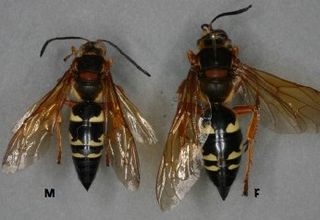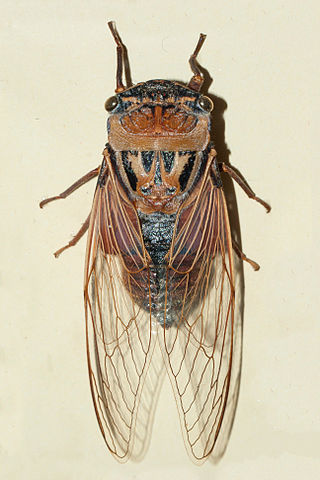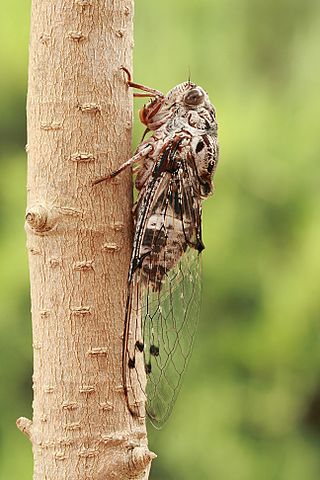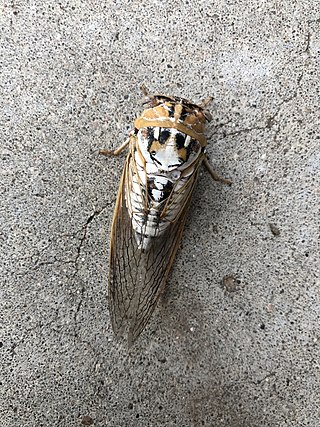
The cicadas are a superfamily, the Cicadoidea, of insects in the order Hemiptera. They are in the suborder Auchenorrhyncha, along with smaller jumping bugs such as leafhoppers and froghoppers. The superfamily is divided into two families, the Tettigarctidae, with two species in Australia, and the Cicadidae, with more than 3,000 species described from around the world; many species remain undescribed. Nearly all of cicada species are annual cicadas with the exception of the few North American periodical cicada species, genus Magicicada, which in a given region emerge en masse every 13 or 17 years.

Ficus macrophylla, commonly known as the Moreton Bay fig or Australian banyan, is a large evergreen banyan tree of the Mulberry Family (Moraceae) native to eastern Australia, from the Wide Bay–Burnett region in the north to the Illawarra in New South Wales, as well as Lord Howe Island where the subspecies F. m. columnaris is a banyan form covering 2.5 acres or more of ground. Its common name is derived from Moreton Bay in Queensland, Australia. It is best known for its imposing buttress roots.

A tarantula hawk is a spider wasp (Pompilidae) that preys on tarantulas. Tarantula hawks belong to any of the many species in the genera Pepsis and Hemipepsis. They are one of the largest parasitoid wasps, using their sting to paralyze their prey before dragging it to a brood nest as living food; a single egg is laid on the prey, hatching to a larva which eats the still-living host. They are found on all continents other than Europe and Antarctica.

Sphecius speciosus, the eastern cicada-killer wasp, is a large, solitary digger wasp species in the family Bembicidae. They are so named because they hunt cicadas and provision their nests with them. Cicada killers exert a measure of natural control on cicada populations, and as such, they may directly benefit the deciduous trees upon which the cicadas feed. Sometimes, they are erroneously called sand hornets, despite not truly being hornets, which belong to the family Vespidae.

Cicadas of the genus Neotibicen are large-bodied insects of the family Cicadidae that appear in summer or early fall in eastern North America and formerly Bermuda. Common names include cicada, harvestfly, jar fly, and the misnomer locust.

Cicada killer wasps are large, solitary, ground-dwelling, predatory wasps. They are so named because they hunt cicadas and provision their nests with them, after stinging and paralyzing them. Twenty-one species worldwide are recognized. The highest diversity occurs in the region between North Africa and Central Asia.

Honeydew is a sugar-rich sticky liquid, secreted by aphids, some scale insects, and many other true bugs and some other insects as they feed on plant sap. When their mouthpart penetrates the phloem, the sugary, high-pressure liquid is forced out of the anus of the insects, allowing them to rapidly process the large volume of sap required to extract essential nutrients present at low concentrations. Honeydew is particularly common as a secretion in hemipteran insects and is often the basis for trophobiosis. Some caterpillars of Lycaenidae butterflies and some moths also produce honeydew. In addition to various sugars, honeydew contains small amounts of amino acids, other organic compounds, and inorganic salts with its precise makeup affected by factors such as insect species, host plant species, and whether a symbiotic organism is present.

The Bembicini, or sand wasps, are a large tribe of bembecid wasps, comprising 20 genera. Bembicines are predators on various groups of insects. The type of prey captured tends to be rather consistent within each genus, with flies (Diptera) being the most common type of prey taken. Nests are typically short, simple burrows, with a single enlarged chamber at the bottom which is stocked with freshly paralysed prey items for the developing wasp larva; the egg may sometimes be laid before the chamber is completely stocked. It is common for numerous females to excavate nests within a small area where the soil is suitable, creating large and sometimes very dense nesting aggregations, which tend to attract various species of parasitic flies and wasps, many of which are cleptoparasites; in some cases, the sand wasps prey on their own parasites (e.g.,), a surprisingly rare phenomenon in the animal kingdom. Although sand wasps are normally yellow and black, some are black and white with bright green eyes.
Cicada is a superfamily of insects, as well as a genus within that group; Cicada (genus).

The rose robin is a small passerine bird native to Australia. Like many brightly coloured robins of the Petroicidae, it is sexually dimorphic. The male has a distinctive pink breast. Its upperparts are dark grey with white frons, and its tail black with white tips. The underparts and shoulder are white. The female is an undistinguished grey-brown. The robin has a small black bill and eyes.

The chorus cicada, Amphipsalta zelandica, is the most common species of cicada in New Zealand, where it is endemic and found in most areas. They typically live in forests and areas with open bush, where their left-over nymph skins can be seen on tree trunks and branches during the summer months. The males produce their cicada sound in unison, which can reach deafening proportions at the height of their population around February. Groups of cicada can suddenly transition from the typical cicada sound to synchronised clicks, using their wings to clap against the surface they are sitting on.

Thopha saccata, the double drummer, is the largest Australian species of cicada and reputedly the loudest insect in the world. Documented by the Danish zoologist Johan Christian Fabricius in 1803, it was the first described and named cicada native to Australia. Its common name comes from the large dark red-brown sac-like pockets that the adult male has on each side of its abdomen—the "double drums"—that are used to amplify the sound it produces.

Psaltoda moerens, commonly known as the redeye, is an Australian species of cicada. It is distributed through the south-east of Australia, from southern Queensland to South Australia, as well as Tasmania. Populations can vary greatly between years; one year they may be present in large numbers and the next they may be entirely absent. They feed primarily on eucalyptus but also on Angophora trees. As they feed on tree sap they expel small droplets of clear waste fluid. When numbers are high, this can form a constant stream.

A wasp is any insect of the narrow-waisted suborder Apocrita of the order Hymenoptera which is neither a bee nor an ant; this excludes the broad-waisted sawflies (Symphyta), which look somewhat like wasps, but are in a separate suborder. The wasps do not constitute a clade, a complete natural group with a single ancestor, as bees and ants are deeply nested within the wasps, having evolved from wasp ancestors. Wasps that are members of the clade Aculeata can sting their prey.

Aleeta is a genus of cicadas with the only species Aleeta curvicosta, one of Australia's most familiar insects. Native to the continent's eastern coastline, it was described in 1834 by Ernst Friedrich Germar.

Psaltoda plaga is a species of cicada native to eastern Australia, from Maryborough in central Queensland to Bega in southern New South Wales. Adult cicadas appear over the summer and inhabit forested areas near bodies of water. The predominantly black form from the Sydney and Central Coast regions is commonly known as the black prince, while the term silver knight is used for the species as a whole.
The genus Liogorytes comprises a group of large, solitary, ground-dwelling, predatory South American wasps which hunt cicadas as prey. It is related to the more common genus of cicada killers, Sphecius.

Sphecius grandis, also called the western cicada killer, is a species of cicada killer wasp (Sphecius). The western species shares the same nesting biology as its fellow species, the eastern cicada killer. S. grandis, like all other species of the genus Sphecius, mainly provides cicadas for its offspring. It forms nest aggregations and mates and broods once in a year, in July and early August. The wasp is on average 3 cm (1 in) to 5 cm (2 in) in length and is amber-yellow with yellow rings on its abdomen.

Macrotristria angularis, commonly known as the cherrynose, is an Australian cicada native to eastern Australia, where it is found in sclerophyll forests.

Megatibicen dealbatus, commonly called the plains cicada, is a species of annual cicada. Dealbatus is Latin for "whitewashed".

















